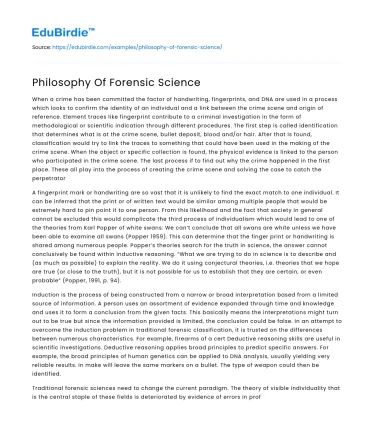When a crime has been committed the factor of handwriting, fingerprints, and DNA are used in a process which looks to confirm the identity of an individual and a link between the crime scene and origin of reference. Element traces like fingerprint contribute to a criminal investigation in the form of methodological or scientific indication through different procedures. The first step is called identification that determines what is at the crime scene, bullet deposit, blood and/or hair. After that is found, classification would try to link the traces to something that could have been used in the making of the crime scene. When the object or specific collection is found, the physical evidence is linked to the person who participated in the crime scene. The last process if to find out why the crime happened in the first place. These all play into the process of creating the crime scene and solving the case to catch the perpetrator
A fingerprint mark or handwriting are so vast that it is unlikely to find the exact match to one individual. It can be inferred that the print or of written text would be similar among multiple people that would be extremely hard to pin point it to one person. From this likelihood and the fact that society in general cannot be excluded this would complicate the third process of individualism which would lead to one of the theories from Karl Popper of white swans: We can’t conclude that all swans are white unless we have been able to examine all swans (Popper 1959). This can determine that the finger print or handwriting is shared among numerous people. Popper’s theories search for the truth in science, the answer cannot conclusively be found within inductive reasoning. “What we are trying to do in science is to describe and (as much as possible) to explain the reality. We do it using conjectural theories, i.e. theories that we hope are true (or close to the truth), but it is not possible for us to establish that they are certain, or even probable” (Popper, 1991, p. 94).
Save your time!
We can take care of your essay
- Proper editing and formatting
- Free revision, title page, and bibliography
- Flexible prices and money-back guarantee
Induction is the process of being constructed from a narrow or broad interpretation based from a limited source of information. A person uses an assortment of evidence expanded through time and knowledge and uses it to form a conclusion from the given facts. This basically means the interpretations might turn out to be true but since the information provided is limited, the conclusion could be false. In an attempt to overcome the induction problem in traditional forensic classification, it is trusted on the differences between numerous characteristics. For example, firearms of a cert Deductive reasoning skills are useful in scientific investigations. Deductive reasoning applies broad principles to predict specific answers. For example, the broad principles of human genetics can be applied to DNA analysis, usually yielding very reliable results. In make will leave the same markers on a bullet. The type of weapon could then be identified.
Traditional forensic sciences need to change the current paradigm. The theory of visible individuality that is the central staple of these fields is deteriorated by evidence of errors in proficiency testing and in authentic cases. Changes in the law pertaining to the admissibility of expert evidence, together with the emergence of DNA typing as a model for a scientifically strong approach to questions of shared identity, are driving the older forensic sciences toward a new scientific paradigm.
Forensic sciences are integrating to move an up and coming doubt about the claims of the traditional forensic individualization sciences. As a result, these sciences are moving toward a new scientific paradigm. From Thomas Kuhn’s concept the five characterizes to prove a theory is valid. They are accuracy, consistency, scope, simplicity and fruitfulness (95). Forensic science can fit within accuracy because at the time of court cases and evidence built up against the perp, it is through the current scientific experiments and observations that come to the conclusion. The accuracy of forensics science paradigm is always being shifted to something new when new equipment come out and new research is found. It can also fit within consistency in that it fits with Karl popper’s theory of white swans and how a fingerprint cannot be reduced to one individual. Forensic science can as well be fruitful, the parameters are constantly changing to advance with technology and use everything at hand to merge what they already know to the new theories being added within the science. Forensic science is transforming itself to be a more grounded science to improve with technology. In the past from new articles people who were convicted of grave crimes have been exonerated by DNA analyses of crime scene evidence that had not been tested at the time of their trials. Flawed convictions sometimes occur, that new science and technology can help distinguish and correct future mistakes.
Sometimes errors occur, if the people doing crime scene work are trained to believe evidence has a limited role and value, more errors will occur. There needs to be a real focus on training to ensure that trace is recognized, recorded and recovered and its assessment documented in the triage or case management phase. There is also a need to better express the different reasons applied to intelligence and investigation or assess results considering hypotheses proposed by others through internationally deductive method. A distinctive, vigorous and more reliable science may emerge through rethinking the forensics paradigm, learning from past errors, revisiting fundamental forensic science philosophies and adapting them to the twenty-first century.
References
- https://www.academia.edu/216906/The_Philosophy_of_Forensic_Scientific_Identification
- https://link.springer.com/referenceworkentry/10.1007/978-1-4614-5690-2_164
- https://www.mitpressjournals.org/doi/full/10.1162/daed_a_00523






 Stuck on your essay?
Stuck on your essay?

